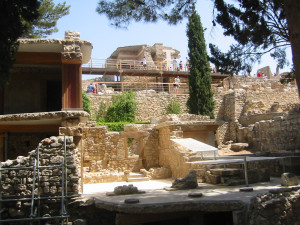The inhabitants of Crete, the largest Greek island, have long suffered a strange libel. The Biblical letter to Titus says that “Cretans are always liars, evil brutes, lazy gluttons.” Michelangelo’s famous Sistine Chapel scene of the Last Judgment shows the legendary Cretan King Minos, with a serpent wrapped around him, judging the damned as they fall into Hell. This painting was based on Dante’s Inferno, in which Minos is depicted with a snake for a tail directing souls of the dead to their proper locations. But Cretans (not to be confused with Cretins) got the last laugh in 1900 when English archaeologist Sir Arthur Evans uncovered on Crete the heart of an advanced civilization existing hundreds of years before civilization came to the Greek mainland. This once-forgotten civilization, now labeled “Minoan” in honor of King Minos, is literally the stuff of legend.
Modern travelers to Crete can visit the restored Minoan palace of Knossos, near the modern city of Heraklion. That large complex, which was built between 1700 and 1400 BC, eventually contained more than 1,300 interlocking rooms on multiple levels. It is the likely source of the ancient myth of the labyrinth, where King Minos is said to have kept the half-bull, half man Minotaur.
The Minoans were the first sea-farers, with ships carrying both goods and culture around the Mediterranean, much of it now on display in the Heraklion museum. Life-size plaster reliefs found at Knossosreflect the imported Egyptian ideal of people shown in profile. Exported Minoan pottery has been found as far east as the Mediterranean coast of modern Israel. In fact, some people think that the Philistines who settled along that coast were actually Minoans who fled Crete when a volcanic eruption destroyed their cities, perhaps giving rise to the legend of Atlantis.
Crete also has something for those whose tastes run more to movies than Minoan and Minotaurs. The fictional tale of Zorba the Greek takes place on Crete and the movie was filmed entirely there. Some of the scenes were filmed in the town of Chania, where one large church has a minaret, reflecting its former use as a mosque after it was once before a church.
Cretans and King Minos have regained their good reputations. But be warned that the Greek Islands were not created equal. If you long to see where European civilization really began, where the Minotaur was kept, and where the legend of Atlantis may have started, a trip to Crete would be a great choice. But if you imagine a Greek island with gleaming white villages on a hilltop above bright blue waters, you should probably stick with Santorini.
